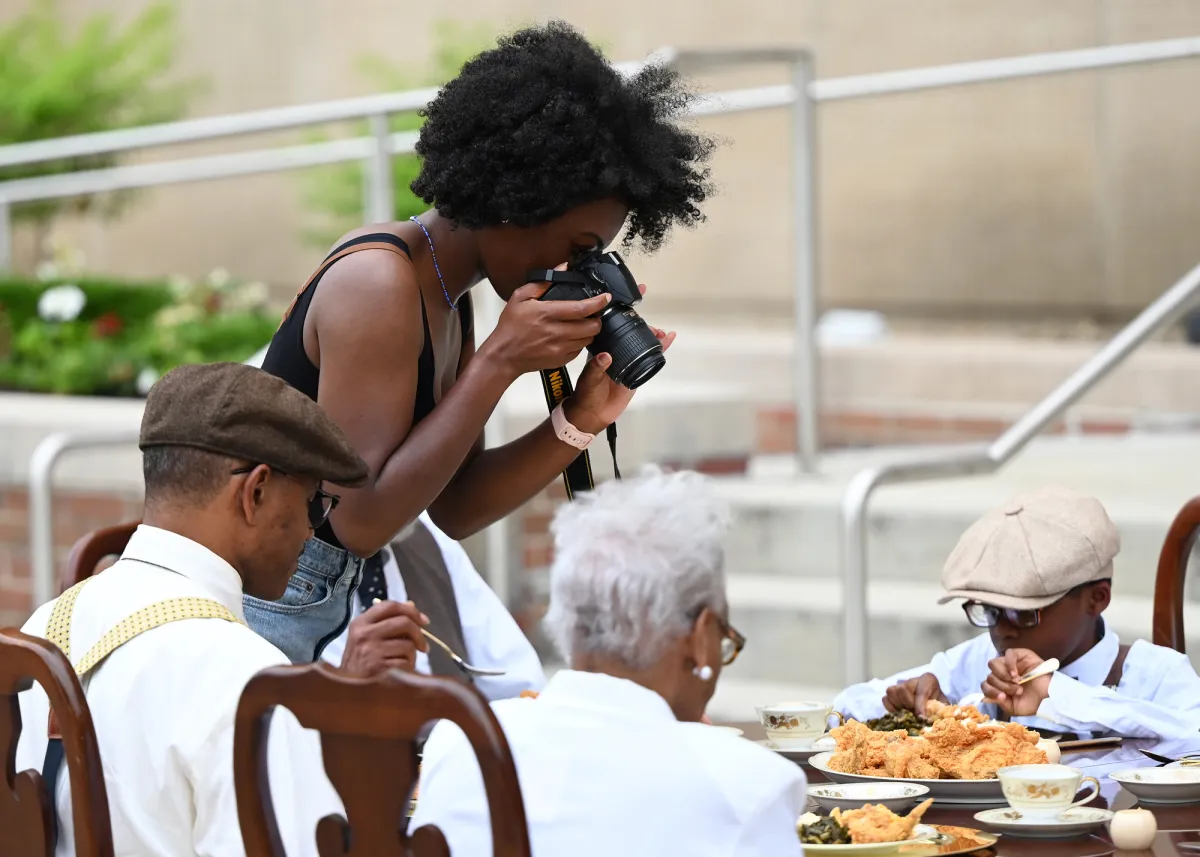IUPUI displaced Black people. Alum’s photography shows what was lost
INDIANAPOLIS (MIRROR INDY) — On a muggy Friday night in June, the Moore family sat down for a family dinner.
John Moore Sr., Joyce Moore, Sophie Covington, and Albert Moore passed platters of fried chicken, greens, and mac and cheese across the table. John and Joyce helped fix plates for their grandchildren, 4-year-old Ayani and 8-year-old John. The family ribbed each other, playfully laughing over the meal.
This wasn’t an ordinary dinner, though — it’s an elaborately staged photoshoot in front of Cavanaugh Hall on Indiana University’s Indianapolis’ campus. Zola Lamothe zipped around the table, capturing family moments with her camera.
Lamothe, an IUPUI alumna, and activist, is staging these photoshoots as part of a project to recreate and photograph historic scenes of Black families on IUPUI’s campus, which was once home to a vibrant Black neighborhood anchored by a thriving business district on Indiana Avenue. In the 1960s, Indiana University began buying up many of the homes and businesses in the area, and many Black families were forced out.

Lamothe found families with ancestral roots in that westside Black community to pose for the photos. A century ago, Covington and John Moore Sr.’s grandfather lived in a home where Cavanaugh Hall sits on what’s now IU’s portion of the former IUPUI campus. IUPUI officially split into Indiana University Indianapolis and Purdue University in Indianapolis on July 1.
In conversations about displacement, Lamothe said, there’s often a tendency to reduce people to numbers. She hopes her photographs are able to show exactly what was lost.
“This is where people started their lives,” Lamothe, 24, said. “This is where people got married. This is where people had their first children. This is where babies took their first steps.
“It’s really about, how are we valuing the lives that are in these spaces, and who is determining which people are worth keeping and are worth building their generational wealth?”
A community connection
Although Lamothe grew up in Indianapolis, she didn’t know about the Black community that had been displaced from the near west side until she had been at IUPUI for several years. Someone mentioned offhandedly that the campus had once been home to a Black neighborhood.
Lamothe was shocked.
“I felt played,” she said. “It’s like when you figure out that Santa is fake, and you’re like, ‘You’ve been lying to me this whole time.’”
After she found out about IUPUI’s history, Lamothe channeled her anger into activism. She came up with the original idea of recreating family scenes for an art class her senior year.
But she was on a budget, so she had to scale down the project. Instead, Lamothe photographed her friends and family holding pictures of westside homes in front of the university buildings that replaced them.
Last fall, Big Car Collective and the Andy Warhol Foundation awarded Lamothe a $10,000-grant to fund her original vision of recreating scenes of community life in front of university landmarks. Her project is titled “Ransom Place: Unveiling a Forgotten Legacy.”
Lamothe doesn’t have any family roots on the west side or Indiana Avenue. But growing up as a Black person in Indianapolis, she feels a certain kinship with the displaced westside community.
“I just really think about the impact that neighborhood brought with Indiana Avenue, the surrounding areas and how they impacted our city as a whole,” Lamothe said.
Showcasing ‘the life of Indiana Avenue’
For the Moores, participating in the photoshoot allowed them to explore a new side of their family history.
Covington remembers their family used to have dinner together every Sunday night when she was growing up. They often congregated at one of her aunt’s houses in the Ransom Place neighborhood.

As Covington, who’s now nearly 90, sat around the dinner table during Lamothe’s photoshoot, she thought of those weekly gatherings she attended as a kid. But she also wondered what her ancestors would say if they knew their old neighborhood had become a college campus.
“I didn’t know my grandparents, but I was thinking about what they would say if they lived in this particular area now the university’s there with the big buildings and the nice campuses,” Covington said.
When her photos are displayed to the public this fall at 1000 Words Gallery on the near east side, Lamothe hopes people recognize the beauty of Indianapolis’ Black history. But she also hopes people feel inspired to fight against displacement and gentrification when it occurs today.
“The life of Indiana Avenue was the people, not just the physical street,” Lamothe said. “I really want people to have pride and gratitude for the communities and the families that lived here.”
Claire Rafford covers higher education for Mirror Indy in partnership with Open Campus. Contact Claire at claire.rafford@mirrorindy.org or on social media @clairerafford.



